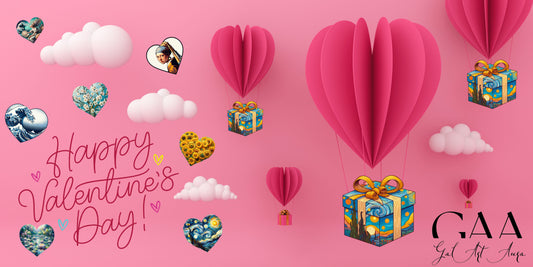What Are the Major Artistic Movements? Discover the History of Art in Depth
Art has always been a reflection of society, history and human creativity. There are many major artistic movements that have shaped the artistic landscape over the centuries. In this article, we will explore in detail these artistic movements, their distinctive characteristics, and the artists who embodied them. Get ready for a journey through art history, from expressionism to pop art, from the 20th century to contemporary art.
Expressionism: The Art of Expressing Emotions
Expressionism was a major artistic movement that emerged in the early 20th century in Europe, primarily in Germany. It was a reaction to the rationality of the late 19th century and emphasized the expression of deep emotions through art. Expressionist artists used bright colors and distorted shapes to convey their feelings. Notable figures in this movement include Egon Schiele and Wassily Kandinsky.
Expressionism left a lasting imprint on the art world, and its influences are still felt in contemporary art today.
Artistic Creation: Pushing the Limits of Imagination
Artistic creation is not limited to a single movement, but is an underlying force in modern art. Artists who push the boundaries of imagination and creativity are often the originators of new artistic trends. Contemporary artist Yayoi Kusama is an example. She is known for her immersive art installations that create endless worlds of pattern and color.
Pop Art: Celebration of Popular Culture
Pop art emerged in the mid-20th century and was primarily associated with American artists like Andy Warhol and Roy Lichtenstein. This movement aimed to celebrate popular culture by using images and objects from everyday life in art. Pop art works were often colorful and bold, reflecting the growing influence of mass media on society.
Contemporary Art: Diversity and Experimentation
Contemporary art encompasses a wide variety of styles, techniques and mediums. There are no strict rules in contemporary art, which allows artists to experiment and push the boundaries of art. It's a world where diversity is celebrated, and art can take many forms, from traditional painting to multimedia installations.
From the Rising Sun Print to American Pop Art
One of the most emblematic moments in the history of art is the emergence of Impressionism in the 19th century, with the work "Impression, Soleil Levant" by Claude Monet, which gave its name to the movement. This artistic revolution marked the beginning of a new era, where artists began to explore light, color and nature in a radically new way.
In the 20th century, art underwent another major transformation with the American pop art movement. Artists such as Andy Warhol used images from popular culture, such as soup cans and celebrities, to challenge the notion of elitist art.
The Emergence of New Forms: Painting, Sculpture and Architecture
Art is not limited to the canvas. Throughout history, many artists have sought to push the boundaries between painting, sculpture and architecture. Movements such as Cubism, which was explored by artists such as Pablo Picasso and Georges Braque, introduced a new way of seeing the world using geometric shapes.
The Main Painters Who Shaped Modern Art
Modern art has been influenced by many visionary painters. Among the most influential are Gustav Klimt, Paul Klee, and Gustave Courbet. Each of these artists brought their unique vision of art, thus contributing to the evolution of modern art.
The Main Artistic Movements at a Glance
| Art Movement | Period | Features |
|---|---|---|
| Prehistoric Art | Before 30,000 BC BC - 3000 BC AD | Rock art, sculptures and primitive pottery. Representations of daily life and wildlife. |
| Art of Antiquity | 3,000 BC BC - 5th century AD AD | Ancient Greece: Marble sculptures, ceramic paintings. Ancient Rome: Mosaics, frescoes, marble sculptures. |
| Renaissance | 15th - 17th century | Interest in perspective and anatomy. Notable artists: Leonardo da Vinci, Michelangelo, Raphael. |
| Baroque | 17th - 18th century | Drama, movement, exaggerated details. Use of light and shadow (chiaroscuro). |
| Neoclassicism | 18th - 19th century | Inspiration in the art of Antiquity. Simplicity, order, balance. |
| Romanticism | 18th - 19th century | Expression of emotions, individuality. Preference for nature, exoticism, the supernatural. |
| Impressionism | 19th - 20th century | Capture light and color effects. Plein air painting, scenes of daily life. |
| Cubism | Twentieth century | Deconstruction of shapes in abstract geometry. Pablo Picasso and Georges Braque as key figures. |
| Surrealism | Twentieth century | Exploration of the subconscious, dreams, irrational. Salvador Dalí, René Magritte, André Breton. |
| Modern Art | 19th - 20th century | Exploration of abstraction, experimentation and new forms of expression. Artists such as Wassily Kandinsky, Piet Mondrian, and Kazimir Malevich. |
| Contemporary art | 20th century - today | Diversity of styles, supports and ideas. Questioning traditional norms of art. |
Conclusion
The history of art is a story of creativity, expression and innovation. The major artistic movements that have emerged over time have helped to broaden our artistic horizons, make us think, and challenge established norms. Whether it's emotional expressionism, the audacity of pop art or the diversity of contemporary art, art continues to evolve and inspire us.
By exploring these major art movements, we can better understand the history of art and the impact it has had on society. Art is a window into the human soul, a form of expression that transcends cultural and linguistic boundaries.
For more details on major artistic movements:
https://fr.wikipedia.org/wiki/Mouvement_artistique
FAQs
Q: What is abstract art?
A: Abstract art is an artistic movement of the 20th century that is characterized by the use of abstract shapes and colors to express emotions, without conforming to realistic representation.
Q: What is outsider art?
A: Outsider art is a form of unconventional artistic creation, often produced by self-taught artists, without formal artistic training.
Q: Who was Caspar David Friedrich?
A: Caspar David Friedrich was an early 19th century German artist known for his romantic paintings focusing on nature and spirituality.
Q: What is the role of the Museum of Modern Art (MoMA)?
A: MoMA, located in New York, is one of the most famous modern art museums in the world, housing an extensive collection of modern and contemporary art.
Q: Which artists were influenced by American pop art?
A: American pop art has influenced many artists, including Jeff Koons, Damien Hirst and Takashi Murakami.
Q: What was the philosophy of the Bauhaus school?
A: The Bauhaus school, founded in Germany, advocated an interdisciplinary approach to art, architecture and design, aiming to combine form and function.













